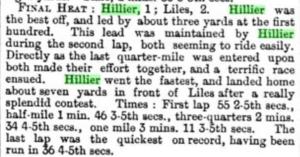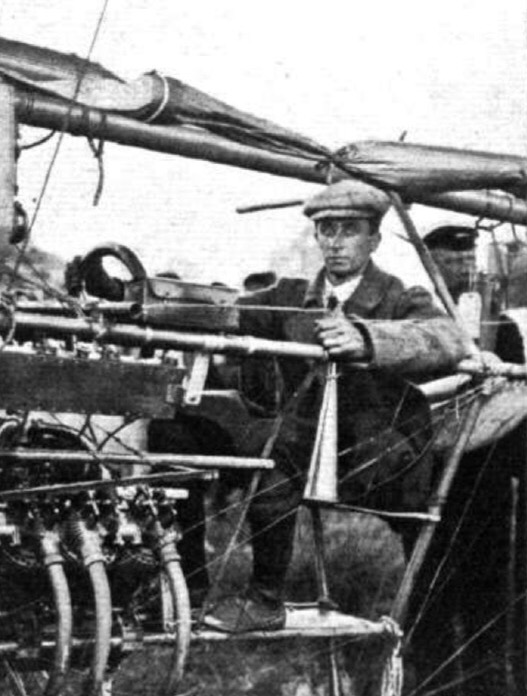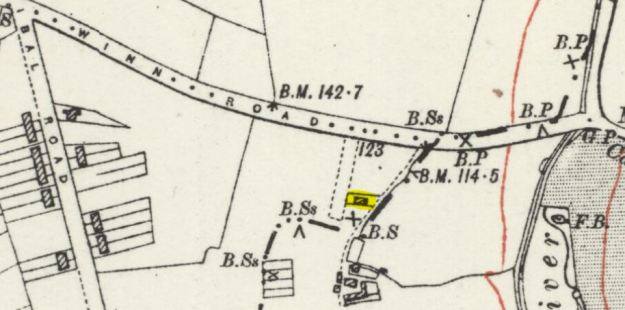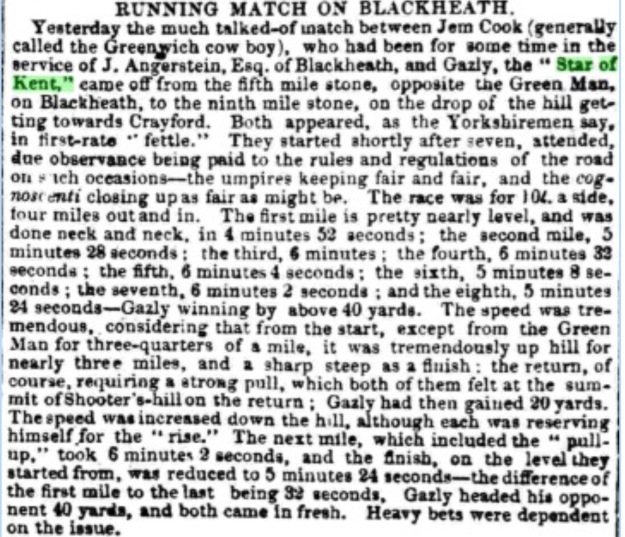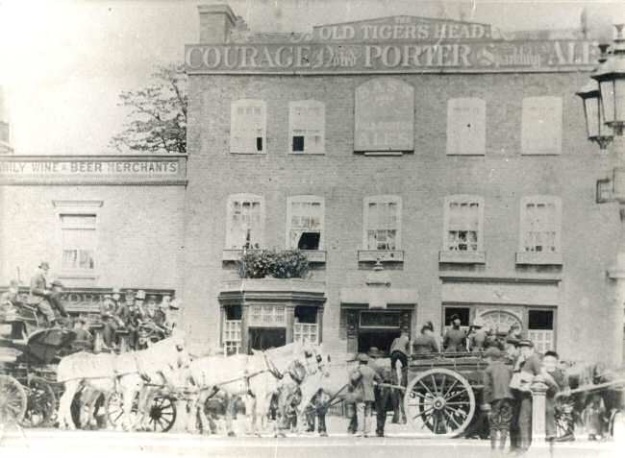Over the years, Running Past has covered a lot of athletes with links to Lewisham and neighbouring areas, including the late Georgian walking pedestrians, such as George Wilson, to the journeymen runners of the 1840s like Tom Cook, the Edwardian professional marathon runner, Charlie Gardiner, and Philip Kingsford, a pioneering triple jumper. Another of these is Henry Hutchins, who competed as Harry Hutchens and was probably the best sprinter in the world of the Victorian era, setting times that are still impressive now. He lived in Catford in the latter years that he was competing and remained there for the rest of his life – he was living at 134 Brookdale Road, below, when he died.
Henry was the youngest of the six children of James and Elizabeth Hutchins; James was a journeyman stonemason who died whilst Elizabeth was pregnant with Harry. In 1861 Elizabeth and the children aged 16 to 4 were living at 4 Gardners Lane, Alpha Place, Putney. The census records are unclear but it is quite likely that Elizabeth and her family were sharing the house with another charwoman and her 5 children. Gardners Lane still exists, renamed at Felsham Road.
The story told in numerous newspaper reports was that he was working as a messenger for WH Smith’s at Putney when he discovered how fast he was able to sprint. He turned professional when he was 18 in 1876.
The way in which professional sprinting was organised in the late 19th century was very different to now. Races were generally handicapped, based on recent form, with the aim of all the sprinters finishing together. So while a race may nominally be over 140 yards, the slowest may have a 30 yard handicap (so start at 110 yards) with the quickest a much smaller handicap and so have further to run. The logic was close races which would generate more betting interest, but times and distances were usually meaningless.
There was prize money on offer, often substantial amounts for the day, but the sport was driven by gambling with the athletes no doubt receiving a cut from their backers. There were also instructions from the backers as to the amount of effort to put in during certain races as this would impact on the handicapping in future races. The athletes were working class men who often made relatively little out of the sport; in this respect not much had changed since the days of the late Georgian walkers like the ‘Blackheath Pedestrian’,Blackheath Pedestrian’, the sprinters, such as William Gazeley, and the distance running ‘pedestrians’ such as the Greenwich Cowboy who were both active in the 1840s.
While races were held all over the country, there were two big venues relating to professional sprinting – Sheffield, mostly based at a pub that is now part of Sheffield United’s ground, Bramall Lane, and at Powderhall in Edinburgh – a New Year’s meeting that Lewisham’s professional marathon runner Charlie Gardiner competed at. Harry Hutchens was to make his name in Sheffield in March 1878 as a 20 year old. He clearly wasn’t unknown to the handicappers as they started him within 5.5 yards of the then Champion, George Wallace, but Harry held on to win by a foot (1).
He was to win again the following year in Sheffield, despite a shortened handicap in the 130 yard race – he had stormed past the rest of the field before the halfway mark to win with ease – afterwards he offered to take on any other sprinter for £500 (presumably not his own money), although he had no takers (2).
While the big money would go to his backers and those who successfully bet on his races, Harry was presumably making some money by 1881 as he had married Harriet in 1880, they’d had a child Hilda in 1880. Harry was described a ‘pedestrian’ in the census, but the successes in Sheffield didn’t mean that he was living in any grandeur; it seems that the house in Grove Terrace in Fulham was being shared with another household, but it was a step up from the cramped conditions he grew up in.
While not winning in 1882, he ran what he regarded as his finest race in Sheffield starting from scratch, he almost overtook sprinters with 7 yard advantages on him completing the 131.25 yards in 12.2 seconds (3). This equates to around 10.3 for 100 metres, but it needs to be remembered that this was on a grass track, in conditions that weren’t ideal for sprinting.
His most impressive time came at the start of 1884 at the New Year’s Powderhall meeting in Edinburgh; it had snowed overnight and the track for the 300 yard race was ‘sloppy’ (4). His dietary preparation for the races was roast beef and potatoes (5). He won his heat in 30.4 seconds and had to run the final with no one within 18 yards of him. Yet he ‘ran through the field like a deer through a frightened flock of sheep’ – winning comfortably in 30 seconds exactly (6). It is now not an often run distance and there is some dispute as to whether the record still stands – but the then European 200 metres Champion, Doug Walker, tried, and failed, to beat it 1999 describing Hutchens sprint as
It was an amazing run, absolutely amazing. Apparently he had his hands in the air, celebrating, from 30 yards out. Some runner.
Later in the year he headed to the United States – although it wasn’t a particularly successful visit, results wise – although he no doubt had appearance money and expenses. He was beaten over 135 yards in Pastime Park, Philadelphia, on November 1 – the winner had a 21 yard start over Hutchens who lost by half a yard. The third placed runner ‘could have won, but did not try’ the reporter noted – presumably on instructions from those funding him who no doubt had money on the other two sprinters. An attempt to run 200 yards in 20 seconds for an ‘imaginary $300’ failed to properly materialise two days later (7). He was sketched wearing somewhat strange sporting attire for the Illustrated Sporting and Dramatic Journal whilst he was in the States (8).

Earlier in 1884, he lost in both February and Whitsun races in Sheffield in front of crowds of over 20,000 – in both outings he struggled against hard handicapping (9).
In 1886 he undertook at provincial tour in the Spring, including 140 yard races over 2 nights in Northampton for prizes of over £8 (10). In the autumn he headed for Australia, hoping that it would improve his rheumatism (11); it was a long voyage during which he was seasick for large amounts of the trip (12).
The hors d’oeuvre was a series of races in just outside Sydney in Parramatta where Hutchens broke the 50 yard record with a time of at 5.6 seconds (13). The main course was a series of races Carrington Grounds in Sydney against Charlie Samuels, an Aboriginal Australian, over 136 yards for £200 and the Championship of the World (14). The first meeting was won by Samuels in 14.9. (15), a race that Hutchens later claimed he ran slow ‘to orders’ – presumably to improve odds in future races.
Samuels again won the second meeting in 15.1 (16), with Hutchens seemingly struggling with sciatica, but as in the previous race may well have been ‘running to contract’ 17). In the final race, Hutchens romped away, finishing in 14.5 seconds, a much quicker time than Samuels had previously managed (18). Also on the trip he beat the Irish sprinter, Tom Malone, who seemed to be struggling with hamstring issues (19).
While Hutchens was travelling back to Britain a new kid on the block emerged, winning impressively in Sheffield – Harry Gent from Darlington. The gamblers that effectively ran the sport set up a high profile match between the Harrys – which was to be held at Lillie Bridge Grounds in September 1887. It was a small arena, close to the current Stamford Bridge, that hosted many sports including boxing, cricket, cycling, football and athletics – Hutchens had already appeared and trained there (20). It is pictured below via Wikimedia Commons

Hutchens decamped to Leicester whilst preparing for the race – believing he would be less likely to be recognised, although was seen training with his coach, Joe Courtney at athletics grounds at Belgrave Road and Aylestone Road (21). Rumours abounded that Hutchens was out of shape and the race would be an easy victory for Gent, there was heavy betting on this basis. The crowd was estimated at between 6,000 (22) and 15,000 (23) paying a shilling to watch the race – the crowd was already there when Hutchens appeared looking very fit. Bookmakers who backed Gent used ‘heavies’ threatened both sprinters effectively preventing them running (24).
What The Times described as ‘The Riot at Lillie Bridge’ ensued with disgruntled spectators feeling that they had been tricked, went on the rampage burning much of the stadium down, with the police and fire brigade seemingly powerless to do anything about it (25). The race was eventually run in at Eslington Grounds in Gateshead, with Gent the victor by a couple of feet (26).
Hutchens (pictured below via Wikimedia Commons) competed infrequently during 1888, one of his few outings was at the Sportsman Running Grounds in Plumstead, under the auspices of Kent Professional Pedestrian Association, his handicap of 20 yards in a 125 yard race seemed to fail to recognise his actual form and he struggled (27). The Grounds, in what are now part of HMP Belmarsh had some other tenants, a football club named after one of the local employers who became much better known – Woolwich Arsenal.
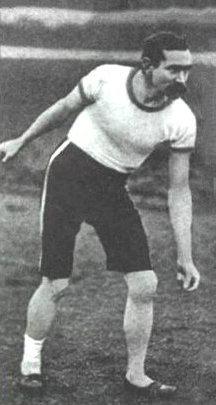
The only significant race he competed in during 1888 was notable only for its strangeness, a man v horse v horse and chariot race in London; Harry was the man and won comfortably over the 2 laps of a tight 150 yard course (28).
1889 seems to have been a year when he struggled with injuries – press reports of his races are few and far between, although the Sporting Life noted that he had ‘ricked’ his leg during May and would be unable to run for ‘some time’ (29). Earlier in the year he had lost in Northampton to W Roseblade, who had a 14.5 yard advantage, over 150 yards, losing out on a prize of £50 and no doubt a cut of betting profits (30). 1890 seems to have been even worse for the now 33 year old with no mentions of races in the press.
Such was his decline that he was described as ‘once famous’ in early 1891 (31). In the short term this perhaps proved favourable to Harry as he was able to win his fourth and final Sheaf House handicap championship in Sheffield in February (32).
In 1892 there were reports of him competing much more than in the previous three years, including several at athletics grounds in Bow on an 800 yard track (33) and a second place in Battersea (34).
As was noted in one of the press reports of a race in 1893, the sport was a decline – ‘professional pedestrian matches are not so frequent these days that a contest between Harry Hutchens….and George Revell, of Newcastle, will pass unnoticed (35).’
It certainly seemed to that way there appear to be no reports of the race which in previous years would have been newsworthy as both were former victors in Sheffield. Hutchens had a rare south east London outing during the year racing at Browns Grounds in Nunhead (now part of Haberdashers‘ Aske’s playing fields), winning his heat but losing in the final (36).
Early in 1894 it was announced that it was to be his farewell season and that he would retire at the end of it. A testimonial was arranged, subscribers included. venues he’d raced at and the Sporting Life. Harry was described as being ‘for sixteen years the champion sprinter of the world’ (37). He made various unsuccessful attempts during the year to beat his own records, often with pacers including ones in Paisley (38) and Stamford Bridge where ‘few were present’ (39).
The testimonial seems to have been a shambles, it’s main backer, the gambler, Sir John Astley, being left out of pocket and Hutchens getting nothing from it (40).
Probably as a result of the lack of income from the testimonial, reports of Harry Hutchens retirement ended up being premature, he was reported as having entered several races during 1895, although there were few results in the press – although he comfortably got through to the final of a race in West Bromwich in February (41), the result of the final didn’t seem to get a mention in the press though.
As we have seen, before his ‘retirement’ Hutchens had taken part in some odd races. This continued into 1896 when Hutchens featured in several runner v cyclist sprints; track cycling was in the midst of a major boom with ‘cycling grounds’ and velodromes springing in numerous locations. One of the these was at the newly built Catford Velodrome (pictured below, via eBay in February 2016), a long sprint from what was to be his home – where, in front of a 10,000 crowd (no doubt there in the main to see the cycling) he comfortably beat the professional cyclist Tom Osborn (42). In a similar race in Walsall he raced a cyclist over 100 yards, being only overhauled by the cyclist, Sam Vale, in the last few yards in front of 2,000 (43).
There were a few outings in 1897 including another unsuccessful race against the cyclist C F Barden in Wood Green (44) along with a heat win in a Christmas race in Leeds, although how he fared in the later rounds is not clear (45).
There were a few more traditional sprint races in 1898 – including revisiting West Bromwich where he had an easy win in the first heat, but the match being abandoned after disturbances concerning Hutchens opponent in the second round Hammond Jump (46). Later in the year he lost to the Scot A R Downer in Rochdale for a relatively large wager (47)
While well into his 40s Harry continued to occasionally race in 1899, he just lost to the much younger Charles Harper in Hanley over 200 metres despite having a handicap of 7 yards for a £50 prize (48). Hutchens did win one race that year when he competed in a strange 120 yard race against a woman cyclist at Putney Velodrome – he was described as ‘ungallant enough to beat’ Rosa Blackburn (49).
His last race, other than a strange race in his 50s (50), was one of his regular appearances in the West Midlands – it drew in the crowds in Bilston, but handicappers on the 120 yard race were harsh – with Hutchens on ‘scratch’ he was beaten by a lad (junior) with a 40 yard start in a ‘magnificent race.’ (51)
During most of his professional career he lived in Fulham with wife Harriet (born in 1859) and daughter, Hilda (1881) he seems to have moved to Catford and started working for the Woolwich Arsenal around 1899. How this happened isn’t clear, but certainly the Woolwich Arsenal appeared sympathetic to the career of another local professional athlete – the marathon runner, Charlie Gardiner, who worked there in the early 1900s. By 1901 he was listed as a ‘Foreman In Royal Naval Ordnance Depot’ living with his wife Harriet, daughter Hilda (listed as a ‘Fancy Knitter’) and a lodger at 12 Bradgate Street (now Road).
While he’d had a successful career, it was no doubt others that had earned far more than Harry had through the gambling that pervaded the sport. The failure of his benefit probably meant that he had little to show from his lengthy career. It isn’t clear whether this contributed to Harry being arrested and found guilty of the theft of a charity box from a Northampton pub, he was sentenced to 14 days hard labour in 1903 (52).
He was still working at Woolwich Arsenal in 1911, listed as a ‘Leading Hand’ there – he’d moved down the street to locally and was now at 38 Bradgate Street– a relatively near neighbour of probably the oldest World War 1 soldier, Alfred Figes, at 79. The household and trades were still the same though and there was a different lodger there.
Harriet died in 1930, but at the time of his death in 1939 when Harry died he was still living in the same bit of Catford, now at 134 Brookdale Road with Hilda and a different lodger. Hilda died in Lewisham in 1952.
His death on 2 January 1939 was fifty-five years to the day after he had covered 300 yards in 30 seconds on a cold winter’s day in Edinburgh, a performance that still impresses historians of athletics. It was to be the defining moment of his career – a time that is still impressive given the conditions, the nature of the track and the lack of modern training techniques and diet.
Notes
- Edward S Sears (2015) Running Through The Ages (Second Edition), McFarlane & Co, Jefferson North Carolina p76
- ibid p76
- ibid p76
- Edward S Sears (2008)George Seward: America’s First Great Runner, Lanham, Scarecrow Press p179
- 06 January 1939 – The Scotsman
- Sears (2008) op cit, p179
- 19 November 1884 – Sporting Life
- Illustrated Sporting and Dramatic Journal, November 22 1884
- 22 January 1885 – Sporting Life – London
- Sporting Life 2 April 1886
- Sears (2015) p77
- The Sportsman 28 October 1886
- 02 March 1887 – Sporting Life
- Sears (2015) p77
- ibid
- ibid
- ibid
- 02 March 1887 – Sporting Life
- Sears (2015) p78
- 06 January 1939 – The Scotsman
- 10 September 1887 – Sporting Life
- The Times, 21 September 1887
- Sears (2015) p78
- ibid
- The Times, 21 September 1887
- 31 October 1887 – Lancashire Evening Post
- 27 April 1888 – Kentish Mercury
- Rugby Advertiser 6 October 1888
- 14 May 1889 – Sporting Life – London, London, England
- Sporting Life 30 January 1889
- 03 January 1891 – The Graphic
- 11 February 1891 – Yorkshire Evening Post
- 26 December 1892 – Sporting Life – London,
- 30 March 1892 – Sporting Life
- Pall Mall Gazette 30 December 1893
- 23 May 1893 – The Sportsman
- 12 January 1894 – Sporting Life
- 09 January 1894 – Sporting Life
- Penny Illustrated Paper 31 March 1894
- 12 December 1927 – Athletic News – Manchester, Lancashire, England
- 09 February 1895 – Sporting Life – London, London, England
- 04 May 1896 – St James’s Gazette – London, London, England
- 08 August 1896 – Sporting Life – London, London, England
- 31 July 1897 – Rugby Advertiser
- 22 December 1897 – Sporting Life – London, London, England
- 02 March 1898 – Sporting Life
- 16 September 1898 – The Salisbury Times
- Manchester Evening News 8 August 1899
- Illustrated Sporting and Dramatic News 13 May 1899
- Hawick News and Birder Chronicle 9 August 1912
- Sporting Life 18 October 1899
- Bolton Evening News 1 August 1903
Census and related data is via Find My Past (subscription required)
Thank you to Mike Guilfoyle for jogging my memory about Harry





































